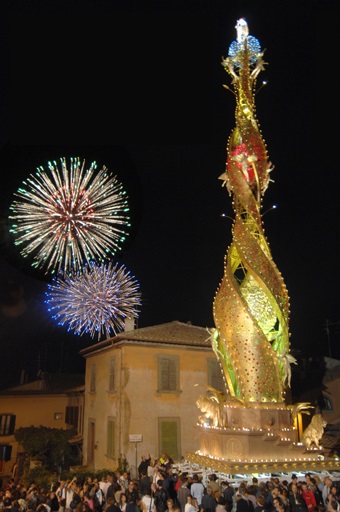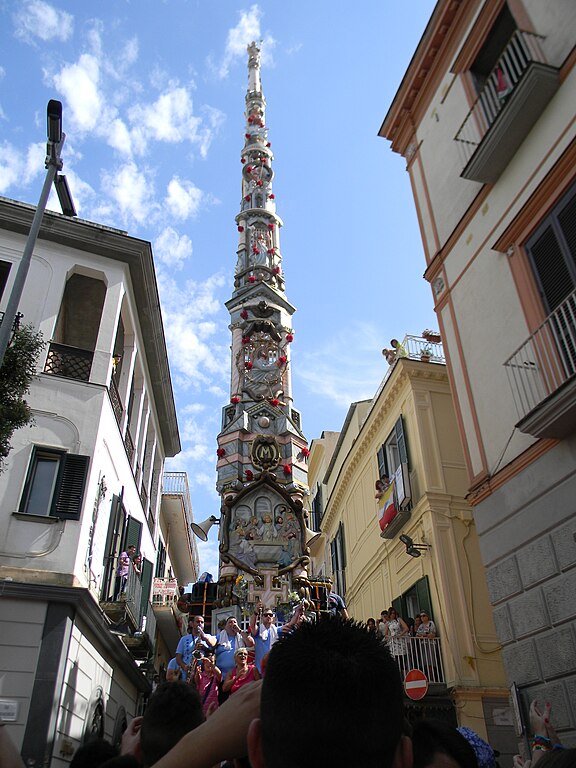Celebrations of big shoulder-borne processional structures
The celebrations of big shoulder-borne processional structures originate at the end of the sixteenth century. When, in the geographical area of central Europe, religious feasts were born. In which the people wanted to get closer and closer to God. And, in this sense, were built machines carried on the shoulders, at which top were placed icons, images or statues of the Virgin Mary or the holy Apostles. Therefore the constructions of the shoulder-borne processional structures assumed an irregularly conical shape. With a particular commitment dedicated to the best setting in terms of height. As if to say that the higher you went, the closer you were to God.

Borrowing a term from classical Greek theatre, this whole structure is called “machine”. The big shoulder-borne processional machines. That is, those gigantic devotional structures carried in procession in some important Italian religious feasts. Have in common the theatricality and the grandeur of the scenography apparatus. In addition to the vast popular participation that has remained unchanged over the centuries. To defend and enhance these ancient traditions, Unesco in 2013 declared these festivals an Intangible Cultural Heritage of Humanity. So, four festivities in central-southern Italy received the coveted recognition.
- Machine of Santa Rosa in Viterbo (Lazio),
- Varia in Palmi (Calabria),
- Feast of the Lilies in Nola (Campania),
- Faradda di li Candareri in Sassari (Sardinia).
THE MACHINE OF SANTA ROSA – VITERBO
The people of Viterbo have always liked to organize and participate in processions with canopies. And also votive altars to show their religious fervour. Certainly, the Machine of Santa Rosa is an imposing construction. That is carried on the shoulders of about 100 “porters” through the streets of the historic center of Viterbo. On the evening of September 3 of each year. Starting from the historic 4 September 1258, the day of the feast of Santa Rosa. This event is the most important of the year and attracts many thousands of people to the city of Viterbo. Santa Rosa died in 1251 AD. And although her body was buried in the bare earth. Exhumed and then usurped by a fire, it still appears miraculously uncorrupted.
On the afternoon of September 2, you can watch the solemn procession in honor of Santa Rosa. 300 actors in beautiful period costumes accompany the Sacred Heart of the Saint. Through the streets of the city of Viterbo. Then, the transport starts from San Sisto Square, near Porta Romana, where the machine was assembled in the previous weeks. Along the way, one kilometer long, there are five stops. At the end of the transport the Machine of Santa Rosa stops in front of the Sanctuary of Santa Rosa. Where it remains for a few days. On 3 September, after following a ritual path, the 100 “porters” in charge of transporting the Machine leave from the Sanctuary of Santa Rosa. And then trace back the path that they will have to cross with the Machine on their shoulders.
At night

The Santa Rosa machine consists of a tower lit by torches and electric lights. Made with an internal infrastructure in metal and modern materials such as fiberglass. The height of the structure varies according to the projects. But is still around thirty meters and the weight about five tons. The machine is illuminated by many lights that are part of the construction, some electric, others with open flame.
The tradition of these richly decorated machines. Covered with precious cloths and carried on the shoulders of the faithful. And followed by the Clergy, the Authorities and the various Corporations, dates back to the 14th century. The first known sketch of the Machine of Santa Rosa dates back to around 1690. It is a simple Baroque altar with a statue of Santa Rosa kneeling in prayer at the top. However the style of the structures will remain virtually unchanged for centuries. So, the variations are only the elevation of the structure and the multiplication of friezes, cherubs and torches.
THE VARIA – PALMI
The Varia is a popular feast that takes place in Palmi (in the province of Reggio Calabria) in honour of Mary Most Holy of the Sacred Letter, patron saint of the city. On the last Sunday of August, every other year. The event is probably the main feast of the Calabria Region. The Varia is a huge chariot 16 meters high and weighs 200 quintals. It represents the Universe and the Assumption of the Virgin Mary into heaven. Above the machine, carried on the shoulders by 200 “Mbuttaturi” (bearers, who represent the five ancient city corporations), is the icon of Mary Most Holy of the Sacred Letter. And there are also human figures representing the Madonna, the Eternal Father, the Apostles and angels.
Celebrations of big shoulder-borne processional structures

Another important moment of faith is the procession. The day before the transport of the Varia, of the picture of Mary Most Holy of the Sacred Letter. And also the reliquary of the Holy Hair. In 1575 a plague epidemic broke out in Messina, Sicily. The citizens of Palmi welcomed anyone fleeing the city and sent all kinds of aid. As a sign of gratitude to the Calabrian town. The city of Messina donated to Palmi one of the three hairs of the Madonna. That were brought to the Sicilian city in 42 AD.
The current icon of Mary Most Holy of the Sacred Letter, venerated in Palmi, is a work of art. Made in 1774 by an unknown artist. The Varia event had already been catalogued as an “intangible heritage” of the regions of Italy. By the Central Institute for Demoethnoanthropology. The municipal administration of Palmi organizes the religious feast. With the patronage of the Province of Reggio Calabria, the Region of Calabria and also religious institutions. From 1900 to today, the Varia has had various awards. For example, the cover of an issue of the magazine La Domenica del Corriere, the issue of a stamp and combined with a national lottery.
THE FEAST OF THE LILIES – NOLA
The Feast of the Lilies is a popular Catholic festival. Held every year in Nola, Campania. During the occasion of the patronal feast dedicated to San Paolino. Which celebrates his return to the city from imprisonment by the barbarians in the first half of 5th century. San Paolino was a noble and rich man who decided to distribute his huge wealth to the poor. As a result for his good spirit people elected him Bishop of Nola by popular acclamation.

Afterwards, in 409 the Goths destroyed a large part of Nola, taking people in hostage. And San Paolino offered himself in exchange for their release. Taken prisoner, he was released in 431 AD. And he returned to Nola, where the townspeople welcomed him with wonderful flowers: lilies.
Today the inhabitants of Nola, to celebrate San Paolino, erect 8 Lilies-machines. With 25 meters high and weighing over 25 quintals. Transported through the alleys of the city centre by about 130 people. The “lilies” are wooden constructions. Decorated by local artisans with decorations in papier-mâché, stucco or other materials according to religious, historical or current themes. Each machine is lifted and handled on the shoulder by 128 people. In addition, representing the boat that brought San Paolino back to Nola, a boat-shaped structure is in the centre of the machines.
Celebrations of big shoulder-borne processional structures

On June 22 of each year, 8 wooden obelisks named after the guilds that transport them, depart from Chathedral Square. And then dance in the alleys of Nola, accompanied by dances and popular music. Until late morning the next day. The feast consists of a dancing procession of 8 machines plus a lower boat-shaped structure. That symbolizes the return to his homeland of San Paolino. Whose sacrifice the feast commemorates. The preparation of the feast lasts a whole year.
The celebration takes place along a path identified in the oldest part of the city. At the rhythm of original songs and reinterpretations taken from the Neapolitan, Italian and international musical tradition. Performed by a musical band placed at the base of the structure. The tradition of the feast is intertwined with that of the guilds. In which, above all, the obligations of devotion on the occasion of the patronal feasts were precise. Certainly aimed at consolidating the internal relationships and the relationships of the members with the remaining part of civil society.
THE FARADDA DI LI CANDARERI – SASSARI
The Descent of the candlesticks (in Sassari dialect “Faradda di li candareri” or just “Faradda”) is a feast held in Sassari, Sardinia. That occurs in the evening before the feast of the Assumption (Ferragosto). And consists of a dancing procession of large wooden columns, symbolic candles, called “candelieri” (li candareri). Which takes place along Corso Vittorio Emanuele II up to Porta Sant’Antonio. And also from Corso Francesco Vico up to the church of Santa Maria of Bethlehem. It is also called “Festha manna”, or “Great feast”. And, according to tradition, it derives from a vow made to Our Lady of the Assumption. Who would have saved the city from the plague.
On August 14, 12 candlesticks divided into guilds descend from Piazza Castello. Up to the church of Santa Maria di Betlem. The party starts at 9:00 in the morning, firstly with the dressing of the candlesticks and decorations. And ends late at night. The “Faradda” is escorted to Bethlehem square by the musical band. Each candlestick, accompanied by the sound of the drum, performs numerous performances along the way. For instance, spinning on itself in the crowd. And also quickly changing direction.
“Candle” Dance

According to an old tradition, the more the candlestick will be “baddarinu” (dancer), the better the year will be. Then when the candlestick reaches Largo Porta Utzeri. The open space where one of the entrances to the city was once located. It performs an auspicious dance to symbolically block the return of the plague. According to tradition, the last death person of the plague in the city would in fact come out of that door.
The feast was born in Pisa at the beginning of the 13th century. As an offering to the Virgin Mary. On the evening of August 14, people carried in procession large wooden machines covered with wax and depicting saints. And also biblical episodes. Each machine, in the shape of a tabernacle, therefore similar to an altarpiece. Was transported to the cathedral accompanied by music. The cities allied to the Republic of Pisa (such as Sassari for example) perhaps contributed to the oblation of the candles of the Maritime Republic. And later practiced the rite themselves every eve of August 15th.
Resume
In Italy there is a strong respect for the “Feasts of big shoulder-borne machines”, which became an Intangible Cultural Heritage of Humanity in 2013. These are peculiar rituals that involve mammoth structures. Built by local artisans, transported along a specific path. Weighing on the shoulders of the faithful. Each participant, who has certainly a role transmitted from generation to generation, fundamental for the success of the event, develops a sense of belonging to the community. And also strengthens social and cultural identity. So, the four celebrations of big shoulder-borne processional structures recognized by Unesco are: the Machine of Santa Rosa in Viterbo. The Varia di Palmi. The Feast of the Lilies of Nola and the Faradda di li Candareri of Sassari.
